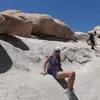Practice Water Safety
If your camping getaways involve swimming and water holes, be sure that your family follows proper water safety guidelines. This might include using flotation devices for small children or staying close to shore. The Red Cross recommends the following tips:
- Read all signage and know the waters you're in. If you're boating, observe the speed limit; if you're swimming or kayaking, be wary of deep water and currents.
- Check the weather before heading out for water activities. Rain or thunderstorms are no time for water sports.
- Use a feet-first entry method in case the water is too shallow.
- Do not drink alcohol when boating, diving or swimming; this can put everyone in a dangerous situation.
Watch Out for Poisonous Plants
Hiking is an all-inclusive way to experience nature, but it's easy to chase a butterfly off of the trail and run straight into poisonous plants. Especially with little ones, keep an eye out for poison ivy or poison oak, and make sure nothing gets eaten.
More: How to Avoid Poisonous Plants
Bring a Map
We've become accustomed to GPS, but in the wilderness, you may not be able to pick up the signal you need. Proper camping safety dictates that you not only have a map of the wilderness area, but also that you take it with you on all treks.
More: Find Your Way: Learn the Basics of Map and Compass
Avoid Propane Stove Danger
An extra stove can be handy at the campsite, but has potential to be dangerous. Never leave the stove idle with the propane on, and follow manufacturer directions if it's your first time using it.
In general, you want to run the propane only when you're about the light the burner. Be sure the ignition dial is turned on low to avoid fireballs and possible burns. Finally, remember to keep all body parts away from the stove when igniting. To do so, use the stove's igniter switch whenever possible, as this spark is contained within the stove. This is safer than using a lighter or matches.
Bring a First Aid Kit
Even with all the precautions you take, you may still need to bandage a bleeding knee or clean a cut. Make sure you always have a first aid kit with antibacterial ointment and bandages.
More: What to Pack in Your First Aid Kit
 Book your next camping trip
Book your next camping trip
- 2
- of
- 2
About the Author









Discuss This Article